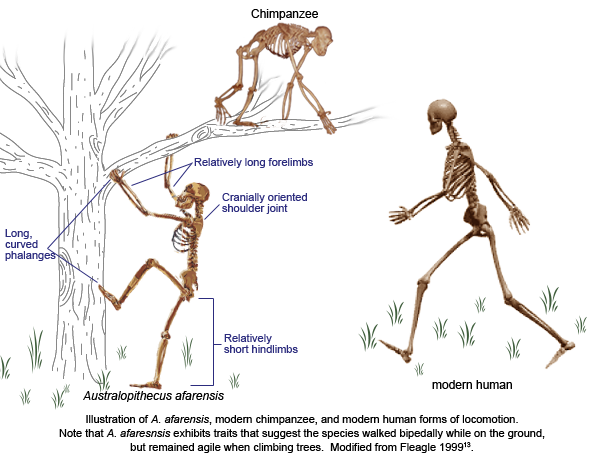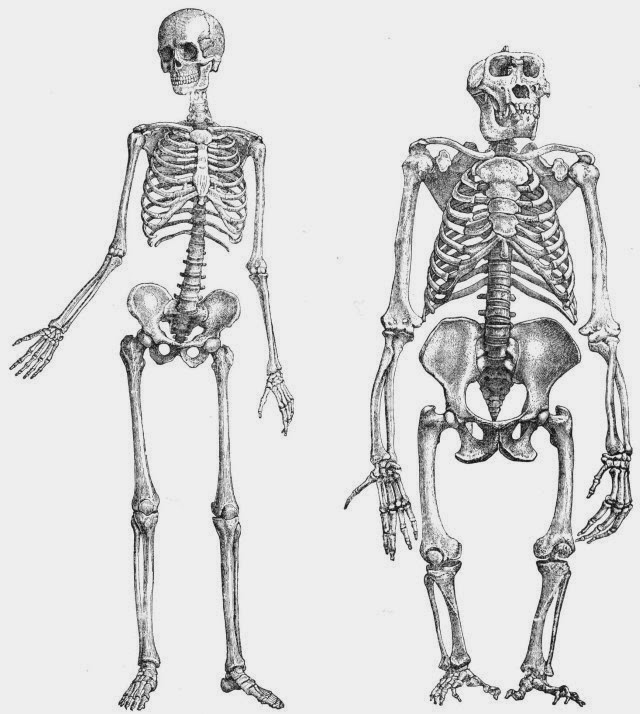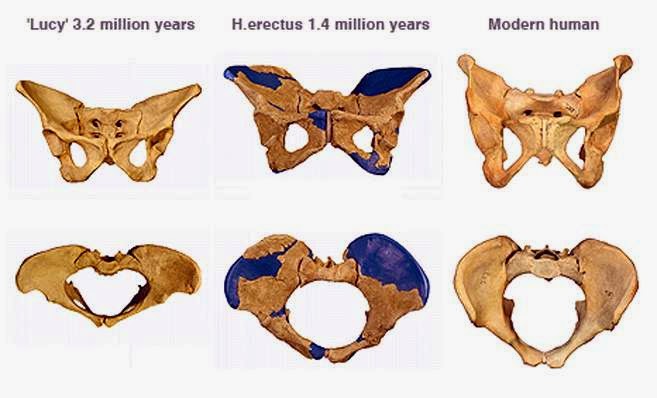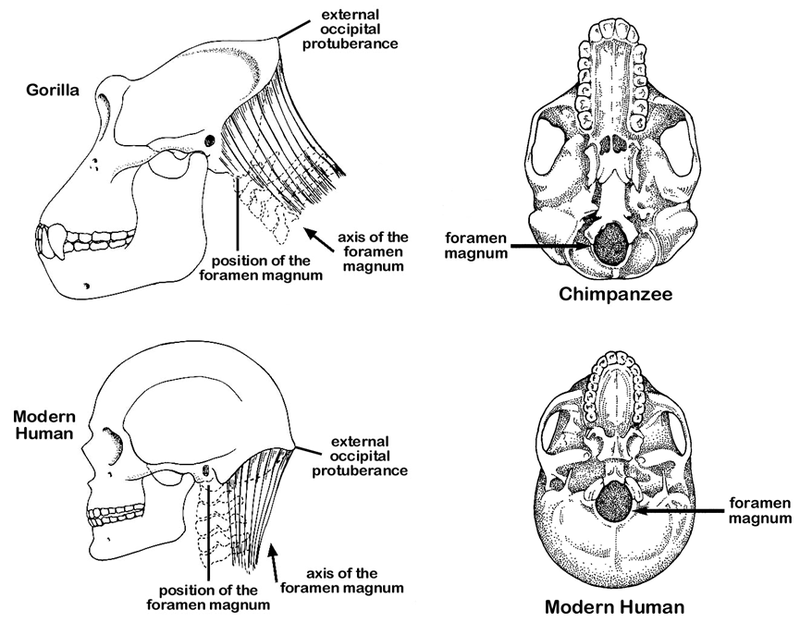Through Bio-cultural Evolution Modern Man Emerged
Human behavior and culture has had profound effects on our evolution. Everything from where we live to what we eat has led to who we are today. As the first modern humans migrated from the warm, equatorial climate of Africa they evolved to have less body hair and melanin so that they could still absorb much needed vitamin D in areas with less direct sunlight. Humans in colder areas also developed vasoconstriction to conserve energy and restrict heat loss. It can be assumed that these early humans made clothes to protect their bodies from the elements, but they were likely made of perishable materials, so there is no direct evidence supporting this. Through cultural adaptation, our ancestors made it possible for us to live outside of tropic environments and inhabit all corners of the globe.
There is direct evidence that early humans used fire to cope with colder environments. Layers of ash found at the Zhoukoudian site has indicated that
Homo erectus used fire to keep warm, paving the way for modern
Homo sapiens to use fire to cook food. There is evidence that
Homo habilis was the first bipedal primate to eat meat. This change in diet provided the high levels of protein that made increased brain size possible. The emergence of meat in their diet came along with the development of certain tools used to hunt and prepare meat. The creation of spears allowed our ancestors the ability to hunt larger animals with less risk of injury. Rather than having to be in close proximity to their prey, they could throw their spear from a much safer distance. The process of preparing meat was also simplified by the creation of a bi-face hand axe which allowed them to efficiently cut through meat. This had a direct effect on facial structure, specifically a reduction in teeth size. As tools became more complicated they also began to include more intricate design and even decoration. Symbolic representation began with utilitarian objects such as tools but soon spread to paintings on cave walls and sculptures solely for artistic expression.
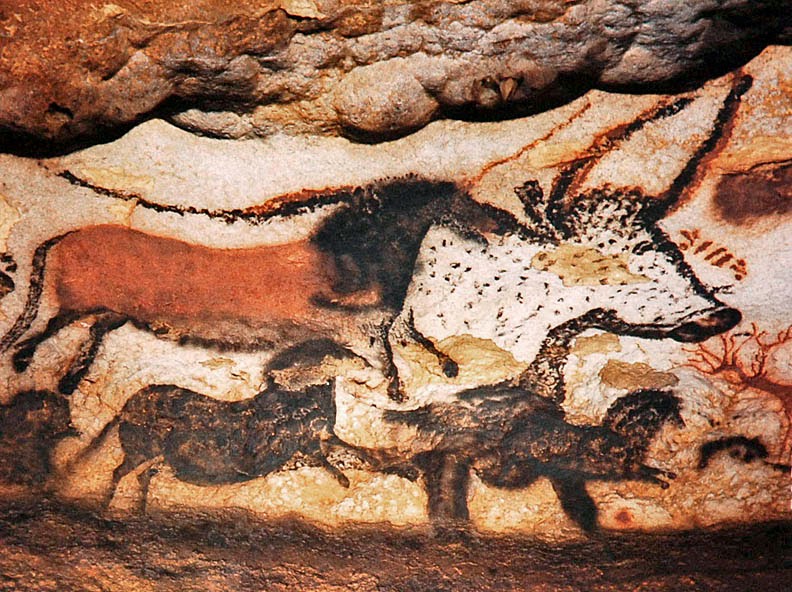
Although the exact meaning of their artwork is unknown it is obviously a reaction to the world around them which consisted mainly of animals. This demonstrates their ability to communicate external influences. Unlike their earlier primate ancestors, they were able to communicate in a way that expressed more than just their current emotional state. At some point, gesture-call systems became spoken language that could communicate abstract ideas through the modification of preexisting neural pathways and vocal tracts. This had huge implications for the future of the human race. Our ability to communicate complex concepts with one another has allowed us to interact socially with one another and work in groups.
The Evolution of Language
Perhaps the most fascinating human adaptation is that of language. With language humans can communicate an infinite variety of feelings, emotions, ideas, information, instruction and so on. Unlike the simpler call systems found in other animals, language involves symbolic communication. Symbolic communication is a huge step over those more basic communication systems, because the use of symbols allows an additional layer of abstraction from that which is expressed in a simpler form of communication. For example, a chimpanzee might make a certain call to communicate information or emotion. So if it is angry, it can make a certain shreik, and its peers will know what it is feeling. Humans can perform these communications as well, but with language, we can move from merely expression immediate emotions, to communicating meta-information, that is, communicating about something, rather than merely invoking that something immediately.
In symbolic communication, information can be communicated in the abstract, outside the immediate context that the information might usually arise in. This ability for abstract, symbolic communication seems to underpin a great deal of human cognitive ability, and in turn is responsible for a vast array of social interactions that no other species is capable.
Explanations as to exactly how this faculty for language is embodied in the brain and mind have yet to arrive, but it seems clear that the faculty of language must have arisen by some complex processs of biocultural evolution. To what degree is this capacity for language innate, and to what to degree does it depend on cultural transmission? The linguist Noam Chomsky has put forth the Universal Grammar Hypothesis, which postulates that the human capacity for language is more or less entirely innate. As Chomsky says "Birds don't have to learn their feathers, and babies don't have to learn their language." The basic idea is that all languages, however different they are in vocabulary, grammar, syntax etc, ultimately are based on a general plan, and each individual language differs merely in the details of its construction. According to Chomsky, this general plan is somehow built into the human mind and ultimately based in the human genome. Linguists have generally agreed with him, but there is still some disagreement about his hypothesis.
The biological anthropologist Terrence Deacon, a strong critic of Chomsky's theory, has put forth a fascinating thesis, to the effect that the human capacity for language is not entirely innate, but rather is only partially innate, and partially embodied culturally in language itself. In his book, The Symbolic Species: the Co-evolution of Language and the Brain, Deacon argues that Chomsky's Universal Grammar Hypothesis asks too much of human biology, and overlooks some obvious places that human culture could make up for minds that do not come with a fully equipped language faculty. According to Deacon, humans develop their faculty for language from two sources: genetic endowment, and cultural transmission.
His idea is that, although the human mind does not have the full ability to comprehend and produce language built in genetically, language itself has been evolved, through a process of cultural evolution or memetic selection, to use the terminology of Richard Dawkins. Languages, in Deacon's view, have been shaped by centuries of passage through the needle's eye of childrens' minds. In order for a language to survive and propagate, it must be easy for children to learn. If children have difficulty learning a language, it will die out, or be drastically modified by the children themselves, who are the next generation of speakers. Through a process of this kind, human language has been edited and modified to fit the less-than-perfect genetic endowments for language that humans have built in. In turn, human biology has undergone a process of natural selection that has improved its ability to acquire and transmit these cuturally evolved languages.
This is perhaps the most intriguing possible example of biocultural evolution that has yet been proposed. The question of which of these theorists is right, however, awaits further evidence.
Hypothesized Line of Descent Tree for Modern Homo Sapien Sapien
Cassie's Conclusion:
Although evolution at first may seem like the study of ancient history, it is actually a process that is still continuing today. Natural selection has shaped every single detail of our biology by favoring the continuation of traits that were favorable to the survival of our ancestors in particular environments. Yet modern technologies have sheltered us from the elements, and therefore sheltered us from nature's selection. In our past, weak or sickly offspring would have been far less likely to survive to adulthood and pass on their genes. Thus, their inferior genes were weeded out of the population. With modern medicine, we have the ability to manage once lethal diseases or mutations. We are distinct in our ability to invent things that increase our survival rate superficially, but that does not mean that we are exempt from natural selection. In fact, technological advancements have kicked our evolution in to high gear and as science progresses, our species will experience exponential change. We already have the ability to engineer our genes in order to select desired phenotypic outcomes. Perhaps it will not be long before we can give ourselves traits that were never possible before in humans. Although humans have been practicing artificial selection for generations, it is entirely possible that someday soon, we may be able to turn other plants, animals, and ourselves into new species. Things previously only in sci-fi movies, like robotics and artificial intelligence, may eventually change our species much more quickly and markedly than environmental pressures ever have. While medicine has increased our survival rate, it has also...Our technologies are also changing our climate quickly, which will have huge implications for the future of our planet and ourselves. With all of the good that may come from technological advancements, they may cause such drastic damage to our planet as to spell an end to our species.
Sofia:
Through biocultural evolution modern homo sapien sapiens withstood countless environmental pressures. As more pressures arose through the passing years, some forced by anthropogenic influences, modern man will have to continue to evolve or perish as its previous ancestors. Through natural selection the evolution of bi-pedal primates gave rise to a rapidly adapting species. Global Warming is a major environmental pressure I infer will affect homo sapiens genotypically which will lead to phenotypic changes in populations. Increase in the mean annual temperature of the lower atmosphere and oceans is a naturally occurring phenomenon. However, it is immensely being influenced by human activity. The burning of fossil fuels emits greenhouse gases into the atmosphere. These gases enable the mechanisms which trap infrared energy in the lower atmosphere. Technological innovations provided modern man with ability to harness a variety of different forms of energy, but at what costs? Heating of the Earth will disturb populations all around the world; overtime these environmental climate changes will presumably alter genes as indicated with the past. Extreme alterations in climate will modify agriculture, migration, wildlife, seasonal weather patterns, ocean currents, as well as topography. Although changes physically may not be observed in this lifetime, global warming will cause change in all fauna and animals possibly alternating numerous food chains and ecological niches. Modern homos need to utilize alternative sources of energy, otherwise greenhouse gases will sustain the increase rate of the average global temperature. Excess amounts of carbon dioxide and other nitrogenous gases can increase health problems which can turn fatal for some modern man if expose to these gases is lengthen. Increasing intelligence is a distinguishing characteristic of bi-pedal primates; I anticipate that modern man has the capacity to develop an alternative energy source to completely stop the use of fossil fuel. 2.6 million years age a small population of individuals thought. And with that one thought ignited the emergence of man's first tool kit. Small alterations to manage with changing weather is only temporary. Climate change however will need permanent innovations to protect the reproductive success of modern homo sapien sapiens. As history concludes bi-pedal primates either succumb to their extinction or prevail over environmental pressures. Through natural selection and other processes modern homo sapien sapien remain the last line of bi-pedal primates.
Kayla:
The process of evolution is a complicated, and sometimes mysterious process that has played a hand in shaping all the species we see on earth. The evolution of hominids is something that we are still working on understanding fully. There are many gaps in our knowledge due to that fact that this process has spanned over millions of years. It is fundamentally crucial to look to our ancestry to understand why modern Homo sapiens sapiens are the way that they are. The study of past hominids has revealed many things about modern humans. For example: bipedality. Without studying the changes seen in our ancestors that led to bipedality we might not have understood why humans are on two legs while all other mammals are not. Even understanding why humans developed bipedality while other primates with whom we shared a common ancestor did not is very important. The point at which modern humans began advancing technologically and culturally is one of our most important developments. It is what separates us from the other hominids. Even the Homo sapiens neandertalensis, who lived at the same time as early humans, was different in some very important way. This difference could account for the extinction of Neanderthals and the survival of humans. As for where humans are headed in the future as far as evolution, who knows. With our rapid advancement in modern technology it is hard to say how we will evolve because each generation is advancing their technology so quickly. There is also the issue of pollution which will obviously have an effect on future generations because living in a polluted habitat can be extremely detrimental. Hopefully, we will focus ourselves more on using our advance technology to help preserve our world. If not, perhaps this mistreatment of the earth will lead to our downfall as a species.
Krishan:
Mankind has emerged out of a whole set of long, complex evolutionary processes. Beginning with a ape-like ancestor approximately 6 million years ago, a wide range of bipedal hominids evolved in varying circumstances in Africa. The path that those hominids took in their evolution resulted in many variations, but a general trend of encephalization - larger brain to body mass ratio - and more complex behavioral traits can be observed in the archaeological and paleontological records. Earlo Homo dispersed from Africa and tried its living methods in other environs that those in which it evolved. These challenges - finding new ways to exploit the environment - were crucial selection pressures that led to the evolution of modern humans. The essential feature that makes humans so powerfully unique is that humans have a very rich culture, a culture that is orders of magnitude more complex and deep and quickly changing than any other animal species. This culture allows humans to do something no other species can: evolve ways to exploit new environments without evolving genetically. We can evolve culturally to find new ways of living. This ability must have evolved through a fantastically complex path of biocultural evolution, in which hominid bodies and minds were made to compete in a cultural world, evolving better and better mental capacities to live in that cultural world. Language is perhaps the most fantastic bioculturally evolved animal trait. It allows humans to transmit information, ideas, and emotion symbolically, and thus allows human cognition to step outside of the narrow locus of basic survival, and move on to grasping deeper truths. Much remains to be understood as to how we came to this happy state. This ensures that physical anthropology will maintain its place as a centrally important discipline for our self-understanding.





